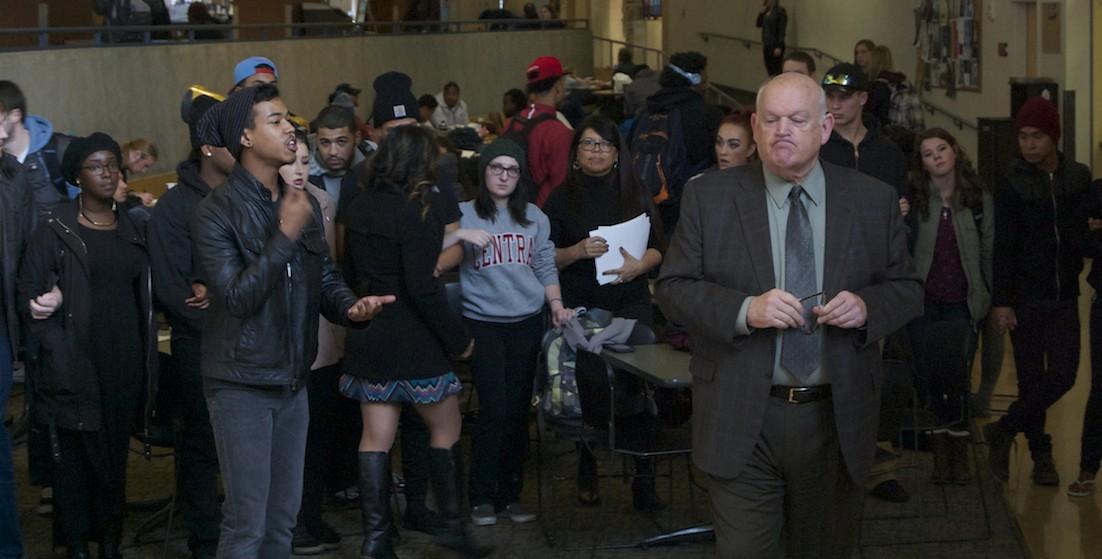Racial tensions rise at Central as students fight for equality
Student activists call out racial injustices on campus, demand administration take action
November 19, 2015
In the 1960s, Martin Luther King stood for racial equality. Half a century later, students at Central are still standing.
About 60 student activists formed a large circle in the middle of the SURC dining area during Thursday’s lunch rush, creating a public forum to discuss racism on campus and in society.
The group requested President James Gaudino’s attendance at the protest, inviting him to stand in the center of the circle so they could vocalize their concerns, ask questions, and make demands directly to the administration.
“My goal was that I wanted to be heard,” said Gianni Glover, one of the event’s organizers. “I used that as a space to create a voice, to get people to hear us, and ultimately to gain the respect we deserve.”
The demonstration was organized as a call to action in response to a letter sent out by the Concerned Student 1950 group – a student group named after the date black students could attend the university – at the University of Missouri.
Beatrice Wambuii, president of Central’s Black Student Union, said the protest was intended to show solidarity with students at the University of Missouri by highlighting similar racial injustices that are occurring at Central.
“I think when we started, it was for Mizzou, but then we started to internalize that the issues happening there aren’t just happening there,” she said. “They’re happening here as well.”
Glover spoke on behalf of multiple students of color, claiming that racial profiling occurs at the hands of some Central professors.
“In the classrooms, there’ve been lots of instances where professors have been overtly racist and prejudiced towards our students and have been hiding behind their freedom of academia.” Glover said.
Other issues that were discussed during the protest included: the underrepresentation of minority student groups on campus; lack of diversity in Central’s staff and curriculum; and an ingrained culture of racism in America.
To address these concerns, President Gaudino promised to attend meetings and events hosted by minority student groups more frequently in an effort to work closely with the protesters towards finding solutions.
Glover, who also serves as the marketing executive for Central’s Black Student Union, said that one of the group’s ideas is to have mandatory racial diversity training implemented for all students and staff at Central.
“I feel that diversity education is important, just like any other skill that Central equips its students with,” Glover said. “In the real world, you have to learn how to deal with different kinds of people who come from different backgrounds and different situations.”
The protest was met with both positive and negative reactions from the Central community.
Wambuii said that physical threats were made against her and other minority students last year during a silent march against police brutality.
“Regardless of what we do, we’re always going to have negative pushback.” Wambuii said.
Wambuii felt that the intensity of the emotions displayed by protesters last week may have caught students in the SURC off guard.
“I think it was just that miscommunication about what exactly are we doing,” Wambuii said. “They saw a bunch of people in a circle yelling, screaming, and crying, so based off the stereotypes we already have as people of color, they just automatically think it’s a violent, negative thing.”
As hundreds of students passing through the SURC gathered around the circle to listen to the discussion, several took to social media to vent their frustrations.
Event organizers said that most of the complaints they heard stemmed from annoyed students who were just trying to peacefully go about their afternoon.
“We’re sitting here saying this is a problem,” Wambuii said. “Yeah, we’re disrupting your lunch and all, but this is something that I have to deal with every single day. It shows what kind of society we live in.”
Many aspects of the Black Lives Matter movement draw inspiration from Martin Luther King’s philosophy of civil disobedience and non-violent disruptions of peace.
Brother 2 Brother president Armando Ortiz said that past demonstrations organized by student diversity groups haven’t gotten much of a reaction at Central, leaving protesters with no other option than to raise their voices.
“We had to be the stereotypical ‘people of color,’” Ortiz said. “We had to be loud for people to hear us, and honestly that makes me mad.”
Glover agreed.
“We’ve tried the quiet approach,” he added. “We’ve been doing it for years. That Thursday was our breaking point. No time to be silent anymore.”
Several students also complained that the Black Lives Matter movement detracts from the problems facing all people.
The protest’s organizers said that the movement is meant to highlight discrepancies between the types of issues people of color face compared to the white majority.
“The All Lives Matter movement to me, personally, is funny,” Ortiz said. “The reason the Black Lives Matter movement was started was because one race is sick and tired of being sick and tired.”
Wambuii and Glover both wanted to clarify that the movement isn’t intended to divide minorities from the rest of society.
“During the entire demonstration, I didn’t say anything about race,” Glover said. “I just talked about underrepresented groups as a whole.”
Wambuii added that her activism is motivated by a desire to see equality for all people.
“It’s for everyone; anyone who has ever been mistreated or underrepresented,” she said. “I would like to speak and be a voice for those who don’t get a chance to.”


Cody • Nov 19, 2015 at 10:44 pm
So I am a white male. Would I be allowed yo join this Black Student Union? If not then you are racially profiling me. That is rascism. Demanding more diverse profressors will not help. If you want that then go to a different school. They hire the Best profressors they can with their budget. Be glad that you will recieve the best education that A the school can provide you and B that you put effort into learning. If you work hard and have the thirst to learn then the teachers will see only a student eager and willing to learn. If you don’t work hard but demand the grades from them they will see nothing but a spoiled, lazy, and undeserving student.
Paul Stayback • Nov 25, 2015 at 8:15 pm
As an alum of CWU, and as a former member of their student government, I can tell you Cody, that yes, you would be allowed to join. as a white man. All student clubs and organizations are open to anyone regardless of race, color, credd, sexual preference or identity, ability, age or veterans status ( i think i got them all, sorry if i didnt). Additionally, allies are welcome and can be valuable for those seeking redress.